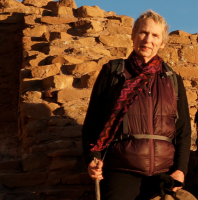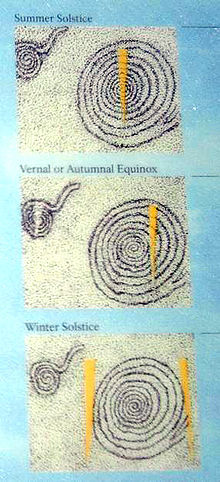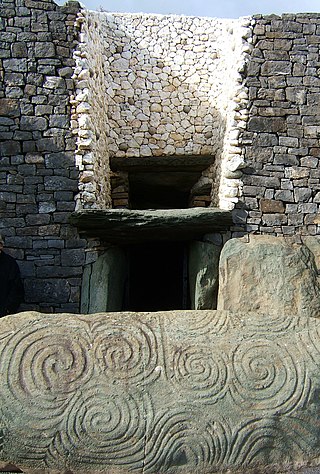
Archaeoastronomy is the interdisciplinary or multidisciplinary study of how people in the past "have understood the phenomena in the sky, how they used these phenomena and what role the sky played in their cultures". Clive Ruggles argues it is misleading to consider archaeoastronomy to be the study of ancient astronomy, as modern astronomy is a scientific discipline, while archaeoastronomy considers symbolically rich cultural interpretations of phenomena in the sky by other cultures. It is often twinned with ethnoastronomy, the anthropological study of skywatching in contemporary societies. Archaeoastronomy is also closely associated with historical astronomy, the use of historical records of heavenly events to answer astronomical problems and the history of astronomy, which uses written records to evaluate past astronomical practice.

Mesa Verde National Park is an American national park and UNESCO World Heritage Site located in Montezuma County, Colorado. The park protects some of the best-preserved Ancestral Puebloan archaeological sites in the United States.
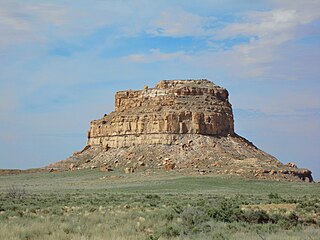
Fajada Butte is a butte in Chaco Culture National Historical Park, in northwest New Mexico.

Chaco Culture National Historical Park is a United States National Historical Park in the American Southwest hosting a concentration of pueblos. The park is located in northwestern New Mexico, between Albuquerque and Farmington, in a remote canyon cut by the Chaco Wash. Containing the most sweeping collection of ancient ruins north of Mexico, the park preserves one of the most important pre-Columbian cultural and historical areas in the United States.

Pueblo Bonito is the largest and best-known great house in Chaco Culture National Historical Park, northern New Mexico. It was built by the Ancestral Puebloans who occupied the structure between AD 828 and 1126.
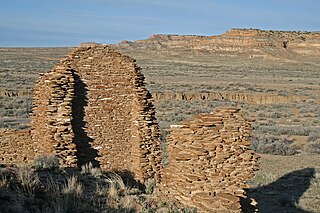
Una Vida is an archaeological site located in Chaco Canyon, San Juan County, New Mexico, United States. According to tree rings surrounding the site, its construction began around 800 AD, at the same time as Pueblo Bonito, and it is one of the three earliest Chacoan Ancestral Puebloan great houses. Comprising at least two stories and 160 rooms, it shares an arc or D-shaped design with its contemporaries, Peñasco Blanco and Pueblo Bonito, but has a unique "dog leg" addition made necessary by topography. It is located in one of the canyon's major side drainages, near Gallo Wash, and was massively expanded after 930 AD.

The Fajada Gap is a geographical feature in the southwestern portion of Chaco Canyon, which is part of the Chaco Culture National Historical Park located in the U.S. state of New Mexico. Surrounding Fajada Butte, it consists of a conspicuous gap penetrating the Chacra Mesa, which comprises much of the southwestern cliff faces hemming Chaco Canyon. Fajada Gap has historically helped funnel summer and winter thunderstorms and accompanying precipitation into the Chaco Canyon area.

Kin Kletso is a Chacoan Ancestral Pueblo great house and notable archaeological site located in Chaco Culture National Historical Park, 25 miles (40 km) southwest of Nageezi, New Mexico, United States. It was a medium-sized great house located 0.5 miles (0.8 km) west of Pueblo Bonito; it shows strong evidence of construction and occupation by Pueblo peoples who migrated to Chaco from the northern San Juan Basin in the time period of 1125 to 1200. From its masonry work, rectangular shape and design Kletso is identified as Pueblo III architecture by prominent Chaco archaeologists Stephen H. Lekson and Tom Windes. They also argue that this great house was only occupied by one or two households. Fagen writes that Kletso contained around 55 rooms, four ground-floor kivas, and a two-story cylindrical tower that may have functioned as a kiva or religious center. Evidence of an obsidian production industry were discovered here. The house was erected between 1125 and 1130.

Chetro Ketl is an Ancestral Puebloan great house and archeological site located in Chaco Culture National Historical Park, New Mexico, United States. Construction on Chetro Ketl began c. 990 and was largely complete by 1075, with significant remodeling occurring in the early and mid-1110s. Following the onset of a severe drought, most Chacoans emigrated from the canyon by 1140; by 1250 Chetro Ketl's last inhabitants had vacated the structure.

Pueblo del Arroyo is an Ancestral Puebloan great house and archaeological site located in Chaco Culture National Historical Park, in New Mexico, United States.
Kin Nahasbas is a Chacoan Anasazi great house and archaeological site located in Chaco Canyon, 25 miles southwest of Nageezi, New Mexico, United States. Built in either the 9th or 10th centuries, it was major pueblo located slightly north of the Una Vida complex, which is positioned at the foot of the north mesa. Limited excavation has been conducted in this area. The ruins are now protected within the borders of Chaco Culture National Historical Park.

Carahunge, also known as Zorats Karer, Dik-Dik Karer, Tsits Karer and Karenish (Քարենիշ), is a prehistoric archaeological site near the town of Sisian in the Syunik Province of Armenia. It is also often referred to among international tourists as the "Armenian Stonehenge".
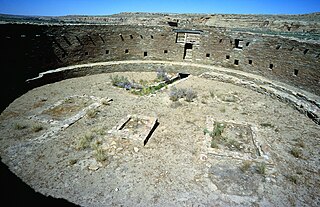
Casa Rinconada is an Ancestral Puebloan archaeological site located atop a ridge adjacent to a small rincon across from Pueblo Bonito in Chaco Culture National Historical Park, northwestern New Mexico, United States.

The Ancestral Puebloans, also known as the Anasazi, were an ancient Native American culture that spanned the present-day Four Corners region of the United States, comprising southeastern Utah, northeastern Arizona, northwestern New Mexico, and southwestern Colorado. They are believed to have developed, at least in part, from the Oshara tradition, which developed from the Picosa culture. The people and their archaeological culture are often referred to as Anasazi, meaning "ancient enemies", as they were called by Navajo. Contemporary Puebloans object to the use of this term, with some viewing it as derogatory.

Shabik'eshchee Village is an archeological site located atop Chacra Mesa, New Mexico. Covering 20 acres (8.1 ha), the pit-house settlement was occupied c. 500–700 by Basketmaker III peoples. Discovered by Frank Roberts in 1926, the site is one of the earliest settlements in Chaco Canyon. Shabik'eshchee Village contained one hundred pit houses and a community great kiva. It is located approximately 9 miles (14 km) east of Pueblo Bonito.

A great house is a large, multi-storied Ancestral Puebloan structure; they were built between 850 and 1150. Whereas the term "great house" typically refers to structures in Chaco Canyon, they are also found in more northerly locations in the San Juan Basin, including the Mesa Verde region. The purpose of the structures is unclear, but may have been to house large numbers of people, religious leaders, or royalty. They were designed and constructed to provide shelter to inhabitants in an arid climate and had protective walls and small windows.
The Chaco Meridian is a north-south axis on which lie the Ancestral Puebloan sites, Aztec Ruins and Chaco Canyon, as well as Paquime at Casas Grandes in northern Mexico. Archeologist Stephen H. Lekson developed the theorizes that the location of these sites approximately on the same line of longitude (107°57'25") was intentional, and represents a ceremonial and political connection between the sites and is due to migration of the rulers of the Ancestral Puebloan moving their capital city.

Guadalupe Outlier is an Ancestral Puebloan site in Chaco Culture National Historical Park, in New Mexico, United States. The site is described by author Stephen H. Lekson as "sitting atop the second-most spectacular setting of any outlier, a narrow high mesa overlooking the Rio Puerco, about 100 kilometres (62 mi) from Chaco". Guadalupe Outlier is the easternmost of the Chacoan ruins and was occupied from roughly 920 to 1130 AD. By the late thirteenth century it had been "remodeled and occupied by a Mesa Verde population". The site was excavated by Lonnie C. Pippin between 1972 and 1975 as part of Eastern New Mexico University's Rio Puerco Valley Archaeological Project. The evidence from Guadalupe Ruin reveals some of these Chaco outliers were established only shortly after the initial development of the Great Pueblos in Chaco Canyon. Throughout their histories, these Chaco outliers were closely related to organized developments in Chaco Canyon and were tied to the Great Houses in the canyon by a network of roads. Nevertheless, despite the architectural similarities and networks of communication between Chaco outliers and the Great Pueblos in Chaco Canyon, the occupants of outlying Chaco towns such as Guadalupe Ruin had a material culture like that of the regionally differentiated village populations.
Gallo Cliff Dwelling is a pair of Ancestral Puebloan room blocks that lie under a cliff in Gallo Canyon, New Mexico, United States. Located adjacent to the National Park Service campground, the site includes a central room that features a multi-storied wall and a five-room structure with kiva that was probably occupied during the early 12th century by Mesa Veredans, who built in a distinctive McElmo masonry style. The inhabitants of these dwellings dates from 1150 to 1200 AD, or the late Chacoan Period. National Park Service excavations there during the 1960s uncovered a quantity of perishable items, including sandals and baskets, from the rooms.
